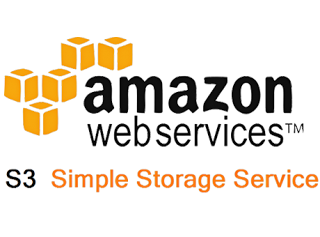Amazon S3
Amazon S3 is an online file storage web service. It stores all types of objects through the web services interface. S3 stands for Simple Storage Service. In a web application, the static contents can pressurize the web server, S3 storage helps to load the images and videos quickly to scale up your website’s performance.
What are You Going to Learn?
- Advantages
- Prerequisites
- Companies depending on Amazon S3
- Terminology used in S3
- How to setup and manage Amazon S3
- Conclusion
Advantages of Amazon S3
- Amazon S3 helps to improve the website/web application performance by loading the static contents and reduce the webserver load.
- Amazon S3 can store any type of file/object in a container which is called ‘bucket’.
- You can store a single object up to the size of 5TB
- Amazon S3 allows you to set permissions to the buckets to read/write using unique key and the authentication setup will keep the data secure from unauthorized access.
- Amazon S3 can be accessed through the Amazon’s management console or using the S3 organizer(S3fox) addon for firefox.
- It is cost effective, quick and reliable storage infrastructure.
Prerequisites
- You must signup for Amazon S3 in your aws account
Companies depending on Amazon S3
- Amazon’s global network of websites using S3 services for storage service.
- Dropbox
- Tumblr
- Storegrid
- InstaGram
Terminology Used in Amazon S3
- Objects
Objects are the basic contents stored in Amazon S3. Each object has object data and meta data. Object data is the original data and the meta data describes the name value of the object. Meta data includes the default value, modified data and Http meta values. We can also customize the meta while storing the object. - Buckets
A bucket is a container of objects. Every object stored in Amazon S3 is contained in a bucket. Buckets will help to organize the objects, identify the account responsible for storage and data transfer, access restrictions using ACL and easy to pull reports. Every object inside the buckets is identified by a key and unique version ID. - Regions
We can choose to create the Amazon S3 buckets in any of the available across the globe.
Objects stored in one region can be transferred to other regions.
- ACL (Access Control List)
In Amazon S3, Access Control List provides privileges to the buckets and objects. Each objects or buckets is associated with ACL and that defines the access to aws accounts and the type of privileges.
When an object is created, ACL offers full control to the owner of the resource. In ACL Grant is an element that identifies the ‘grantee’ (it may be a aws account or predefined group of users) and it is permission. The permission list are as follows, READ, WRITE, READ_ACP, WRITE_ACP and FULL_CONTROL.
In ACL, there are predefined grants available which are called Canned ACLs. The permission list are as follows, private, public-read, public-read-write, authenticated-read, bucket-owner-read, bucket-owner-full-control, log-delivery-write.
How to Setup and Manage S3?
- Login to aws management portal https://console.aws.amazon.com/s3
- Click Create Bucket button.
- Enter a bucket name and make sure it is unique. The bucket name cannot be changed and it is visible in the URL that points to the bucket and object.
- In the Region drop down menu, select a region of your own.
- Click the create button and the bucket will be created.
- Inside you can create folders or upload objects.
- To upload an object, click upload from the web user interface. You can also use S3 Organizer to upload files into the bucket.
- Click Add files and select the file from your computer
- Once it is selected, click Start Upload button to begin the file upload to Amazon S3
- Finally the object will be uploaded and stored inside the bucket.
- By default, the object will have Grantee to owner of the account with open, view and edit permissions.
- By making it public you can set the Grantee to everyone with open/download permission.
- You can use the Link to test your object.
- You can move, copy or delete an object.
- In the properties tab, you can set the permissions and add metadata to the object.
- The Amazon S3 organizer (S3 fox) is an addon for firefox can be used to create buckets and upload/download objects from Amazon S3.
Conclusion
The pricing for Amazon S3 differs for every region and it is a pay for use model. There are three types of charges can be applicable for Amazon S3.
- Storage pricing is for standard storage and reduced redundancy storage.
- Request Pricing is for put,copy and post requests.
- Data Transfer Pricing depends on the in and out data transferred using Amazon S3
- All data transfer IN to Amazon S3 and data transfer OUT to from Amazon S3 to Same region Amazon EC2 are free
- All other transfers are chargeable.



Comments